A story of Franco-German reconciliation
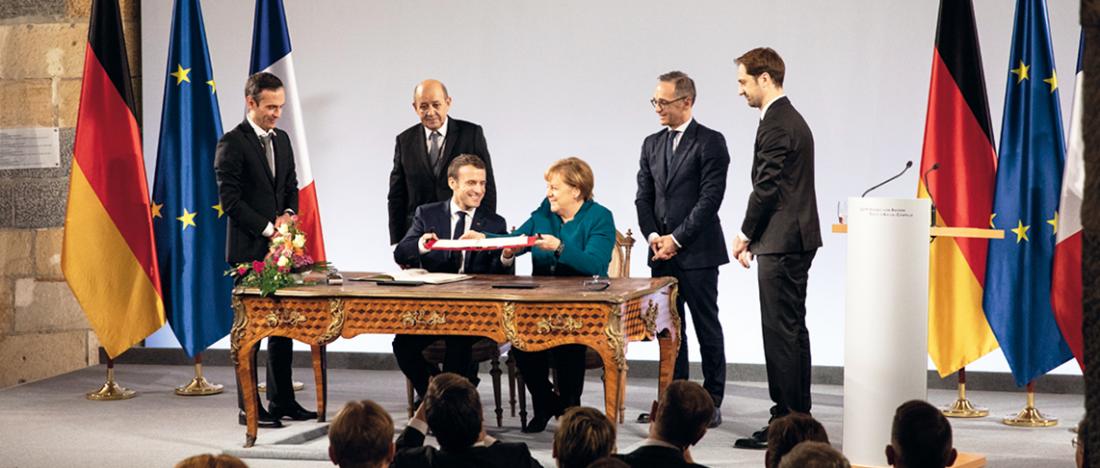
From the origins of the Franco-Prussian War to the present, Franco-German relations have seen many ups and downs, and the two world wars symbolised the ultimate break in relations. The late 20th century was a time for peace, and paved the way for a genuine process of reconciliation. Thus, while bilateral relations between Germany and France may be the result of years of progressive and intense cooperation, they are also indissociable from European integration.
For 75 years, the centre of the European continent was dominated by the confrontations between France and Germany: the Franco-Prussian War (1870-71) and the two world wars. The death toll was appalling: over 70 million dead across Europe and the world, 13 million of them in Germany and France. On the still smoking ruins of these tragedies, however, the course of history was reversed: after the Second World War, Franco-German reconciliation became the driving force for the peaceful (re)construction of Europe.
The long road from enmity to harmony
The wars that had dogged the 19th and first half of the 20th centuries, since the Napoleonic Wars, had instilled in people’s minds a “hereditary hatred” between Germany and France. Going right back to the beginning of the 18th century, there were laudable efforts to build bridges between France and what at the time was the Holy Roman Empire: French novelist Madame de Staël sought to make the Germans more appealing to French eyes, while German writer Heinrich Heine did the equivalent across the Rhine. But theirs were isolated voices, which came up against nationalistic self-interest.
Between the two world wars, there were other attempts, with the French and German foreign ministers, Aristide Briand and Gustav Stresemann, endeavouring to heal the wounds of the First World War and pave the way for constructive relations. Their efforts were rewarded in 1927 with the Nobel Peace Prize, then wiped out by the economic crash and the rise of Nazism.
It was not until the second half of the 20th century that French and German leaders managed to break free from the vicious circle of Franco-German conflicts. If the plan for a European Defence Community (EDC) was rejected in 1954 by the French National Assembly over fears about German rearmament, a “rapprochement” between France and Germany did take place in the late 1940s, through a network of human infrastructure around figures like Abbé Franz Stock, the Jesuit Jean du Riveau, the founder of the Resistance movement “Combat” Henry Frenay and the political scientist Alfred Grosser, and a network of public- and private-sector organisations: the French Committee for Exchanges with the New Germany and the Franco-German Institute in Ludwigsburg were both founded in 1948, local twinning committees were begun in 1950 by the towns of Montbéliard and Ludwigsburg, and the Franco-German Chamber of Commerce was set up in 1955. As early as October 1945, former Dachau deportee Joseph Rovan, future friend and adviser to Chancellor Helmut Kohl, had an iconic article on Germany published in Esprit magazine, which, with its elements of premonition, had a major impact on Franco-German relations and the process of European unification. In it, Rovan wrote of the existence of a shared destiny for the two peoples in Europe, since Germany had ruined Europe along with itself. With Germany now in France’s hands, it would become what France made of her – hence the title of the article: “The Germany of tomorrow will be the measure of our worth”.
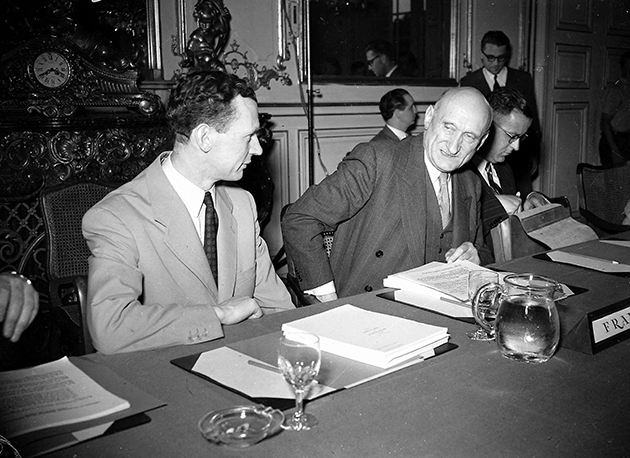
The first meeting of the Council of Europe: Robert Schuman (1886-1963) and Maurice Couve de Murville (1907-99), Strasbourg (Bas-Rhin), August 1949.
© Roger-Viollet
Reconciliation arose out of a desire to finally live in peace. On either side of the Rhine, people had understood that they had to accept constraints in order to transform them into creativity. To begin with, this meant recognising the existence of shared interests, which was the basis of French foreign minister Robert Schuman’s plan for a European Coal and Steel Community (ECSC). Presented on 9 May 1950, it proposed the pooling of what at the time were crucial to war: coal and steel. “The coming together of the nations of Europe requires the elimination of the age-old opposition of France and Germany. [...] [T]he French Government proposes [...] that Franco-German production of coal and steel as a whole be placed under a common High Authority, within the framework of an organization open to the participation of the other countries of Europe. The solidarity in production thus established will make it plain that any war between France and Germany becomes not merely unthinkable, but materially impossible.”
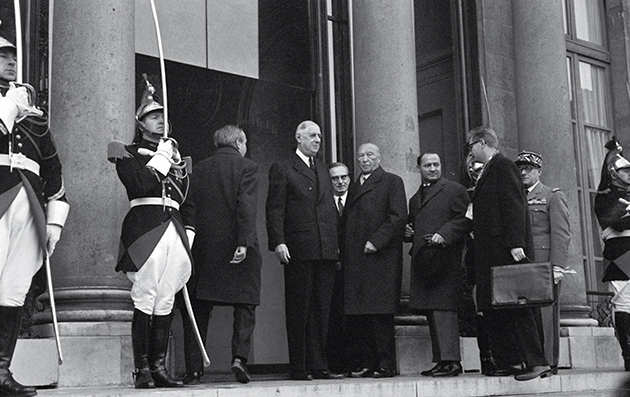
The German chancellor, Konrad Adenauer, is received by General de Gaulle at the Élysée Palace
for the signing of the Franco-German treaty, Paris, 22 January 1963. © Roger-Viollet
The signatories of the Franco-German treaty of cooperation and friendship, known as the “Élysée Treaty”, of 22 January 1963, Charles de Gaulle and Konrad Adenauer, then gave the necessary impetus for the French and German leaders to transcend the complexity of their relationship for the purposes of an exemplary reconciliation that would benefit European integration. Not without its ambiguities and misunderstandings, the entente between the two leaders was based on a shared political desire to contribute to European unity. Their successors, whoever they might be, would maintain a constant dialogue that accepted all the contradictions born out of differences of opinion and approaches to the international situation. The Élysée Treaty, which established regular meetings between heads of state and government and between ministers, in particular concerning foreign policy, was admittedly not a magic wand to advance relations between Paris and Bonn/Berlin; but as a “pacifying” super-structural element, it avoided jeopardising the future of France and Germany, and that of Europe. Thus, during the process of German unification, relations between French and German leaders were so strained that only the habits of cooperation adopted since 1963 prevented more serious disputes. Indeed, it should not be forgotten that, from a French perspective, the division of Germany was in fact the prerequisite for reconciliation with its neighbour. But in 1990, the traditional parameters of Franco-(West) German relations were called into question by the advent of a unified Germany at the heart of Europe. Since the Élysée Treaty, cooperation has steadily deepened. On the 25th anniversary of its signing, in 1988, the Franco-German Defence and Security Council and the Franco-German Economic and Financial Council were established, and in 1989 came the creation of the Franco-German Brigade, which led to the emergence of the Eurocorps in 1993. Following the treaty’s 40th anniversary, in 2003, a general secretariat for cooperation was set up in each country and Franco-German ministerial councils began being held, in place of the Franco-German summits. The Treaty on Franco-German Cooperation and Integration, signed in Aachen on 22 January 2019, built on the Élysée Treaty, moving from the desire for cooperation to convergence in a number of areas, whether economic, military or cross-border. Today, the bilateral relationship between the two countries has no equivalent.
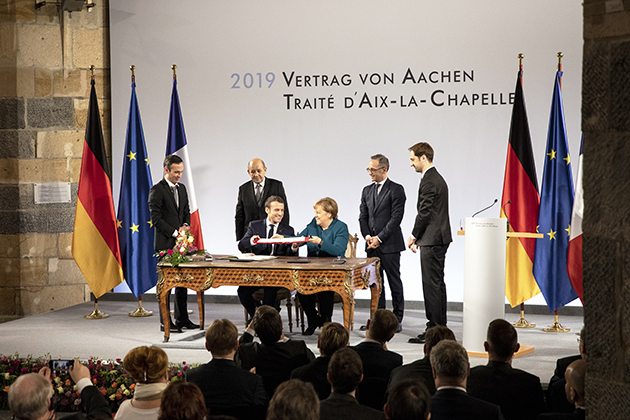
Signing of the Treaty of Aachen by French president Emmanuel Macron and German chancellor Angela Merkel, 22 January 2019.
© Présidence de la République
The Élysée and Aachen treaties led to the establishment of a specific partnership between the two countries, legitimised by a process of construction of reconciliation symbolism.
First World War remembrance: a symbol of Franco-German reconciliation
When we think of Franco-German reconciliation, it makes more “sense” for the First World War than it does for the Second, since Germany occupied France for four years – or the Franco-Prussian War of 1870-71, which caused suffering and consequences on a level not comparable with the two world wars. Of course, any war can be instrumentalised for militant purposes. When the Aachen Treaty was signed in 2019, for instance, some leading French politicians brought up the memory of the Franco-Prussian War by accusing the French president of giving Alsace to Germany, when in fact the treaty is concerned only with strengthening cross-border cooperation for the benefit of the populations involved.
French and German remembrance is not the same: unlike France, where 11 November is a day of “commemoration of victory and peace”, Germany ignores this date in its remembrance calendar, since it evokes the memory of its collapse and the humiliations of the Treaty of Versailles of 28 June 1919, which prepared the ground for the rise of National Socialism, 14 years later. The fact is it was the First World War that was referred to by General de Gaulle and Chancellor Adenauer at the religious service in Reims cathedral on 8 July 1962, and by President François Mitterrand and Chancellor Helmut Kohl as they held hands before Douaumont Ossuary, near Verdun, on 22 September 1984. This stance of the two French and German leaders recalled for the first time the pain and loss of the two nations, thereby turning First World War remembrance into a consensual memory of a terrible, shared experience.
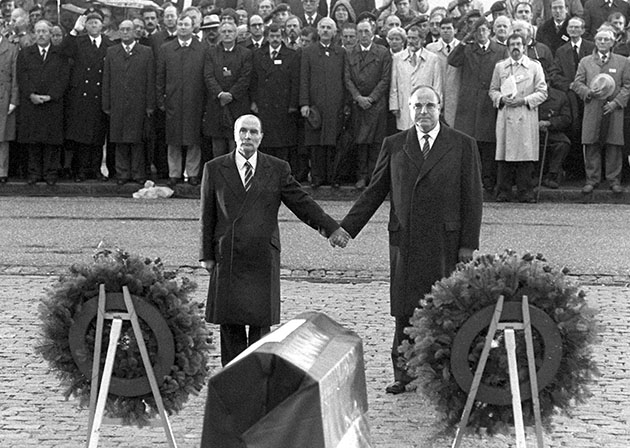
François Mitterrand and Helmut Kohl together remember the Battle of Verdun, Douaumont Ossuary, 22 September 1984. © RDA
On 22 January 2003, the 40th anniversary of the Élysée Treaty, a joint session of the French National Assembly and German Bundestag was held in the Hall of Mirrors of the Palace of Versailles – precisely where the Treaty of Versailles had been signed 84 years earlier and where the German Empire was proclaimed in 1871. On 11 November 2009, Chancellor Merkel and President Sarkozy together rekindled the flame at the Tomb of the Unknown Soldier of the Great War, beneath the Arc de Triomphe – an iconic site of French mythology, which gave this first-ever German presence a particular prestige. It was an event, since it was a transnational ritual that was staged, with the performance of two hymns and the presence of a detachment of the Franco-German Brigade and officer cadets from both armies. President Sarkozy’s speech, while situating itself in the tradition of the gestures of Chancellor Kohl and President Mitterrand, mentioned explicitly the victims from both camps, without any distinction between the dead of one or the other: “On this 11 November [we] are not commemorating the victory of one nation over another, but a hardship that was as terrible for one as for the other.” President
Emmanuel Macron and his German counterpart Frank-Walter Steinmeier took up their place within this tradition when they opened together, on 11 November 2018, the first-ever Franco-German museum of First World War history, the Historial Franco-Allemand de la Grande Guerre, on the Hartmannswillerkopf, in the Vosges mountains. The binational dimension is more thorough than at Verdun, since the Historial is situated in a cross-border region with a population of eight million – an opportunity to create an open, shared, European remembrance of the conflict. Finally, on 10 November 2018, Chancellor Merkel and President Macron together commemorated the end of the First World War in the Rethondes clearing, in the forest of Compiègne, where the Armistice was signed a century before. It was the first time a federal chancellor had ever set foot on this site of capitulation. The two leaders unveiled a bilingual commemorative plaque which stated that they “hereby reaffirm the value of Franco-German reconciliation to serve Europe and preserve peace”.
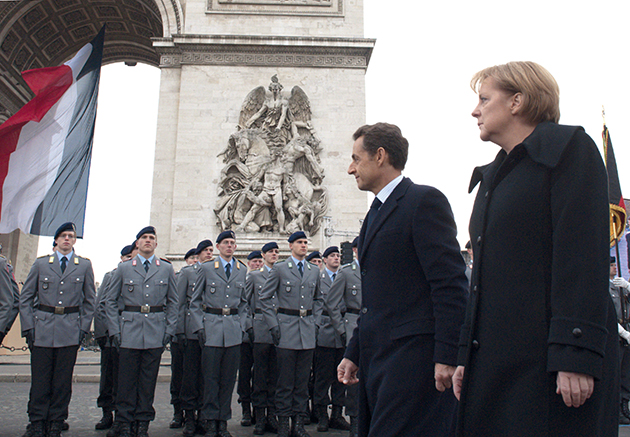
Nicolas Sarkozy and Angela Merkel review German troops at the national Armistice Day ceremony,
Paris, 11 November 2009. © Philippe Wojazer/AFP
Of course, remembrance and commemoration need to have meaning; memories have to be nurtured. And the ink drawn in Verdun having now dried up, to achieve this palimpsest the Second World War also had to be addressed. New anchorage points had to be set, such as mutual understanding and the transformation of places of pain into places of shared contemplation. One such example was the solemn declaration made by President Jacques Chirac on the 40th anniversary of the D-Day landings in Normandy, on 6 June 2004, at the Mémorial de la Paix in Caen, attended by Chancellor Gerhard Schröder: “On this day of remembrance and hope, the French people welcome you more than ever as friends. They welcome you as brothers.”
The mechanics of reconciliation: between forgetting for the sake of peace and looking towards the future
Up until the end of the 1980s, reconciliation was seen, on both sides of the Rhine, as incompatible with confronting the memory of the last war. Indeed, since the ceremony in Reims in 1962, French and German leaders have turned to remembrance sites that are connected with episodes prior to the Second World War. The official Franco-German remembrance thus gave precedence to sites about which there was a consensus (Reims, Verdun or Versailles), as opposed to the historical episodes which fuelled much of contemporary remembrance debates (Drancy, Auschwitz or Oradour-sur-Glane). In this sense, like any historical representation, the grand narrative of Franco-German reconciliation had an element of amnesia to it, for various reasons. First, the “external” context of the Cold War brought the democracies of Western Europe closer together to counter the Soviet threat. Second, mutual accusations concerning episodes of the Second World War could have jeopardised potentially constructive contact. Third, after 1963, French and German leaders were convinced that in order to ensure the success of Franco-German rapprochement, they must at all costs avoid anything that could possibly threaten it. This impasse vis-à-vis the recent past succeeded in concealing both countries’ failure to confront their own past – Nazi war crimes and collaboration. This being the case, the likes of Karl Oberg and Helmut Knochen, high-ranking SS officers in France during the Occupation, were freed in 1962 on the orders of General de Gaulle. France’s indulgence towards them can be explained in the context of the national reconciliation policy of successive French governments and of reconciliation with Germany with a view to signing the Élysée Treaty – which amounted to absolution. In his speech in Berlin on 8 May 1995, on the 50th anniversary of the end of the Second World War, President Mitterrand even dared pay an explicit tribute to the soldiers of the Wehrmacht and their courage. It is not so much about bringing the past into line with the needs of the present than promoting a lasting, redemptive “amnesia” which, without falling into the trap of covering up, allows a painful past be overcome, yet without erasing it. The Great War was such a “positive” force behind reconciliation that President Valéry Giscard d’Estaing decided to keep the 11th November as the only commemorative date, making it a day of remembrance for all wars and doing away with the 8th May.
Already in the 1980s, however, the official milieux in France and Germany gradually agreed to confront the painful episodes of the Second World War – as demonstrated by the trials of Klaus Barbie, in 1987 and Paul Touvier in 1994, respectively head of the Gestapo and head of the Milice in Lyon during the Occupation. The emergence of Second World War remembrance in the Franco-German sphere can be explained by changes in the two societies and states after the end of the Cold War and by a shift in their attitudes towards their own history.
In Germany, the critical confrontation with the Nazi past became predominant in the mid-1980s, in particular with federal president Richard von Weizsäcker’s famous speech in the Bundestag on 8 May 1985, in which he delivered to his compatriots a message of reconciliation with their Nazi past: “The 8th May was a day of deliverance.” After President Mitterrand reinstated the 8th May as a public holiday, in 1981, not to commemorate the victory against Nazism but to celebrate freedom and democracy, the German president’s speech gave substance to that interpretation, which would enable Chancellor Schröder to attend the 60th anniversary of the D-Day landings in June 2004. In France, this critical confrontation reached an important milestone with President Chirac’s speech of 16 July 1995, at the cérémony in memory of the Vél d’hiv roundup of 16 and 17 July 1942, in which, far from de Gaulle and Mitterand’s position on the issue, he officially recognised the French State’s involvement and responsibility in the deportation and genocide of the Jews – later reaffirmed by presidents François Hollande, in 2012, and Emmanuel Macron, in 2017.
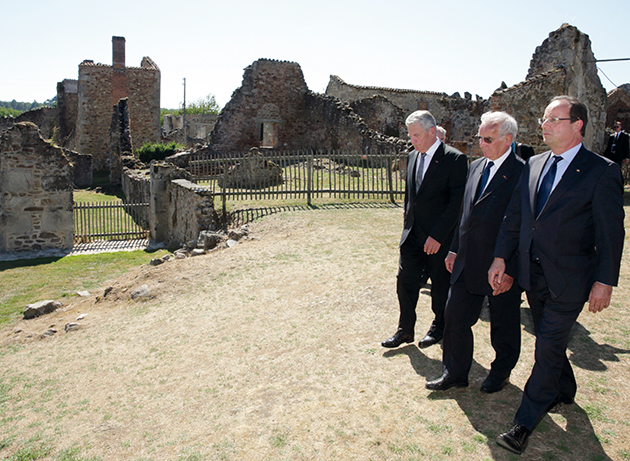
François Hollande and Joachim Gauck visit Oradour-sur-Glane, together with Robert Hebras, a survivor of the massacre, 4 September 2013.
Philippe Wojazer/AFP
The two countries are also better able to look at their shared past together. Since the late 1990s, Franco-German exchange programmes both at civil society level or through the Franco-German Youth Office (OFAJ) have included places and themes directly connected to the history of the Second World War. The production of a Franco-German history manual for French and German high-school students, decided in 2003, is the ultimate sign of reconciliation between two countries wanting to promote a Franco-German perspective on the historical events, in particular the tragedies of collaboration and the genocide of the Jews. On 4 September 2013, President Hollande and his German counterpart, Joachim Gauck, visited Oradour-sur-Glane – where, on 10 June 1944, 643 people were massacred by soldiers of the SS Das Reich division. This new symbolic gesture – and of repentance for Germany – this time at a Second World War remembrance site, shows to what extent the two countries need to continue with the process of reconciliation. It is clear that French and German leaders must not only show that they want dialogue, but that they convey a kind of emotion which goes beyond the regular meetings that have taken place for the past more than 50 years.
In recent decades, French and German political leaders have given the necessary impetus for the two countries to improve the mechanisms for joined-up cooperation processes, set themselves the same targets and take the same paths towards achieving them. It is the reconciliation process that has enabled the two countries to move closer together, and to go on moving closer together today, to the point where it is sometimes claimed they are a “couple”, something which the Franco-German partnership most certainly is not. But this Franco-German rapprochement was truly exemplary and showed a capacity to build a Europe of peace and prosperity. While certain limits of the grand narrative of Franco-German reconciliation might be questioned, one has to admit that it was and remains a lesson in tolerance and solidarity, which could serve as a model for other regions in conflict around the world.

